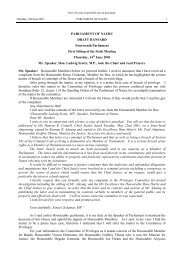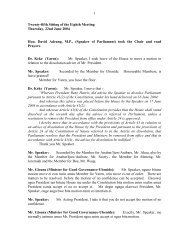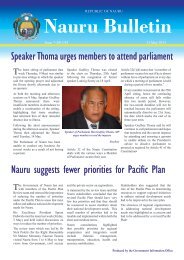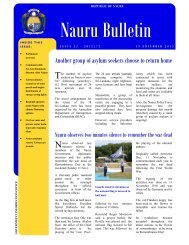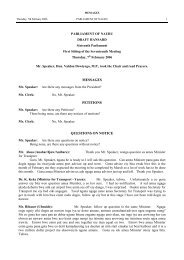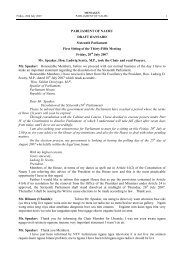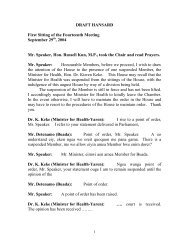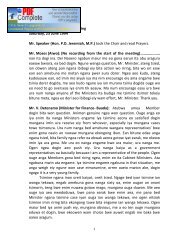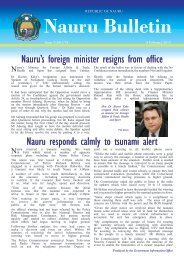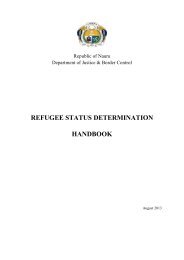No 26 - 13 October 2009 - The Government of the Republic of Nauru
No 26 - 13 October 2009 - The Government of the Republic of Nauru
No 26 - 13 October 2009 - The Government of the Republic of Nauru
Create successful ePaper yourself
Turn your PDF publications into a flip-book with our unique Google optimized e-Paper software.
Almost three in four children (70 percent) with diarrhoea were treated with some<br />
kind <strong>of</strong> oral rehydration <strong>the</strong>rapy (ORT) or increased fluids. More than one in five (23<br />
percent) were treated with ORS, while 30 percent were given recommended home fluids,<br />
and 45 percent were given increased fluids.<br />
Foster-hood and Orphan-hood - About 65 percent <strong>of</strong> children less than 18 years live<br />
with biological parents, while 11 percent live with a mo<strong>the</strong>r but not a fa<strong>the</strong>r even though<br />
<strong>the</strong> fa<strong>the</strong>r is alive. Approximately about one fifth (15 percent) <strong>of</strong> children do not live<br />
with ei<strong>the</strong>r parent and <strong>the</strong>se children were likely to be between <strong>the</strong> ages 15 and 17 years<br />
and from within <strong>the</strong> second economic quintile. Eight percent <strong>of</strong> <strong>the</strong>se children ei<strong>the</strong>r<br />
have one or both parent that has deceased.<br />
Breastfeeding and Nutrition - Breastfeeding in <strong>Nauru</strong> was found to be nearly universal,<br />
with nearly 95 percent <strong>of</strong> children born in <strong>the</strong> five years preceding <strong>the</strong> survey having<br />
been breastfed at some time. <strong>The</strong>re were very little variances to suggest <strong>the</strong> existence <strong>of</strong><br />
significant differences between economic quintiles or <strong>the</strong> poorest households compared<br />
with <strong>the</strong> richest in terms <strong>of</strong> breastfeeding.<br />
Children between <strong>the</strong> ages <strong>of</strong> 6 to 23 months tended to consume foods made from<br />
grains more <strong>of</strong>ten than o<strong>the</strong>r foods. <strong>The</strong> next most commonly consumed food was meat,<br />
fish poultry and eggs, <strong>the</strong> third being fruits and vegetables rich in vitamin A.<br />
In contrast 81 percent <strong>of</strong> children had been fed a minimally diverse diet according<br />
to standards <strong>of</strong> <strong>the</strong> minimum number <strong>of</strong> food groups depending on age and breastfeeding<br />
status, and 43 percent were fed <strong>the</strong> minimum number <strong>of</strong> times appropriate for <strong>the</strong>ir age.<br />
This in perspective translates to two in five children (37.7 percent) aged 6-23 months<br />
met <strong>the</strong> minimum standard with respect to all three infant and young feeding practices.<br />
<strong>The</strong> prevalence rate <strong>of</strong> anaemia among <strong>Nauru</strong>an women aged 15-49 years was 34<br />
percent and was more common among young women aged 15-19 years who have had<br />
two or three children, smoked and found within <strong>the</strong> lowest economic wealth quintile<br />
group. But what is very disturbing is that more than half <strong>of</strong> <strong>the</strong> 255 children aged 6-59<br />
months were found to have anaemia during <strong>the</strong> survey. However, <strong>the</strong> prevalence <strong>of</strong><br />
anaemia showed a declining trend with <strong>the</strong> increase <strong>of</strong> age in children.<br />
HIV, AIDS and STI’s - In <strong>Nauru</strong>, knowledge about AIDS is not as high as o<strong>the</strong>r islands<br />
such Marshall Islands who undertook <strong>the</strong> same survey. Men (83 percent) were found to<br />
be more knowledgeable than women (73 percent) about <strong>the</strong> disease. Questions asked <strong>of</strong><br />
respondents were specifically targeting contraception use, sexual activity and<br />
transmission factors. More information can be obtained from <strong>the</strong> report.<br />
Mortality - In <strong>the</strong> zero to four years age group before <strong>the</strong> survey, <strong>the</strong> infant mortality<br />
rate was 38 deaths per 1,000 live births. This means that four in every 100 babies born<br />
in <strong>Nauru</strong> do not live to <strong>the</strong>ir first birthday. Those who live past <strong>the</strong>ir first birthday will<br />
survive until <strong>the</strong>y reach <strong>the</strong>ir fifth birthday where a fur<strong>the</strong>r 4 in every 100 children under<br />
12



